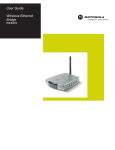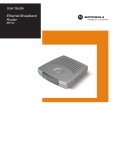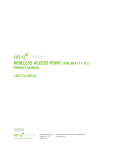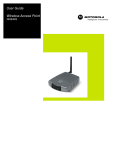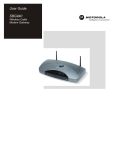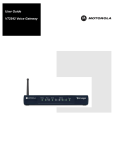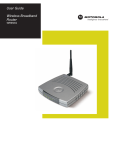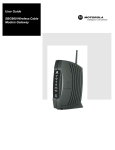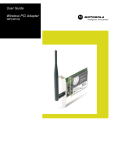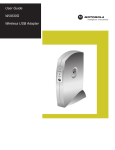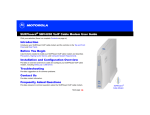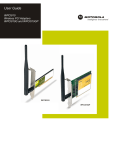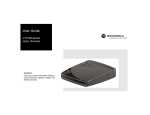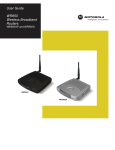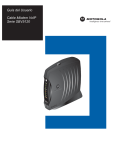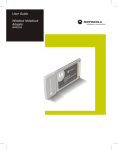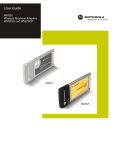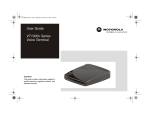Download Motorola WE800G User's Manual
Transcript
User Guide Wireless Ethernet Bridge WE800G This device must be installed and used in strict accordance with the manufacturer’s instructions as described in the user documentation that comes with the product. FCC Compliance Class B Digital Device This equipment has been tested and found to comply with the limits for a Class B digital device, pursuant to Part 15 of the FCC Rules. These limits are designed to provide reasonable protection against harmful interference in a residential environment. This equipment generates, uses, and can radiate radio frequency energy and, if not installed and used in accordance with the instructions, may cause harmful interference to radio communications. However, there is no guarantee that interference will not occur in a particular installation. If this equipment does cause harmful interference to radio or television reception, which can be determined by turning the equipment off and on, the user is encouraged to try to correct the interference by one of the following measures: • Reorient or relocate the receiving antenna. • Increase the separation between the equipment and receiver. • Connect the equipment into an outlet on a circuit different from that to which the receiver is connected. • Consult the dealer or an experienced radio/TV technician for help. CAUTION: Changes or modifications not expressly approved by Motorola for compliance could void the user’s authority to operate the equipment. Canadian Compliance This Class B digital apparatus meets all requirements of the Canadian Interference Causing Equipment Regulations. Cet appareil numérique de la classe B respects toutes les exigences du Règlement sur le matériel brouilleur du Canada. FCC Declaration of Conformity Motorola, Inc., Broadband Communications Sector, 101 Tournament Drive, Horsham, PA 19044, 1-215-323-1000, declares under sole responsibility that the WN825G and WPCI810G comply with 47 CFR Parts 2 and 15 of the FCC Rules as a Class B digital device. This device complies with Part 15 of FCC Rules. Operation of the device is subject to the following two conditions: (1) This device may not cause harmful interference, and (2) this device must accept any interference that may cause undesired operation. Wireless LAN and your Health Caution: Exposure to Radio Frequency Radiation. To comply with the FCC RF exposure compliance requirements, the separation distance between the antenna and any person’s body (including hands, wrists, feet, and ankles) must be at least 20 cm (8 inches). Restrictions on Use of Wireless Devices In some situations or environments, the use of wireless devices may be restricted by the proprietor of the building or responsible representatives of the organization. For example, these situations may include: • Using wireless equipment on board an airplane. • Using wireless equipment in any environment where the risk of interference to other devices or services is perceived or identified as harmful. If you are uncertain of the applicable policy for the use of wireless equipment in a specific organization or environment (such as airports), you are encouraged to ask for authorization to use the device prior to turning on the equipment. The manufacturer is not responsible for any radio or television interference caused by unauthorized modification of the devices included with this product, or the substitution or attachment of connecting cables and equipment other than specified by the manufacturer. Correction of interference caused by such unauthorized modification, substitution, or attachment is the responsibility of the user. The manufacturer and its authorized resellers or distributors are not liable for any damage or violation of government regulations that may arise from failing to comply with these guidelines. FCC Certification The WE800G contains a radio transmitter and accordingly has been certified as compliant with 47 CFR Part 15 of the FCC Rules for intentional radiators. Products that contain a radio transmitter are labeled with FCC ID and the FCC logo. Canada - Industry Canada (IC) The wireless radio of this device complies with RSS 210 and RSS 102 of Industry Canada. This Class B digital device complies with Canadian ICES-003 (NMB-003). Cet appareil numérique de la classe B respects toutes les exigences du Règlement sur le matériel brouilleur du Canada Europe - European Declaration of Conformity All products with the CE marking comply with the EMC Directive (89/336/EEC), the Low Voltage Directive (73/23/EEC), and the R&TTE Directive (1999/5/EC) issued by the Commission of the European Community. Compliance with these directives implies conformity to the following European Norms and the equivalent international standards: • ETS 300-826, 301 489-1General EMC requirements for radio devices. • ETS 300-328-2 Technical requirements for Radio equipment. • EN 60950 Safety Caution: This equipment is intended to be used in all EU and EFTA countries. Outdoor use may be restricted to certain frequencies and/or may require a license for operation. Contact local authority for regulations. Copyright © 2003 Motorola, Inc. All rights reserved. No part of this publication may be reproduced in any form or by any means or used to make any derivative work (such as translation, transformation or adaptation) without written permission from Motorola, Inc. Motorola reserves the right to revise this publication and to make changes in content from time to time without obligation on the part of Motorola to provide notification of such revision or change. Motorola provides this guide without warranty of any kind, either implied or expressed, including but not limited to, the implied warranties of merchantability and fitness for a particular purpose. Motorola may make improvements or changes in the product(s) described in this manual at any time. MOTOROLA and the Stylized M Logo are registered in the US Patent & Trademark Office. Microsoft, Windows, Windows Me and Windows XP are either registered trademarks or trademarks of Microsoft Corporation in the United States and/or other countries. Microsoft Windows screen shots are used by permission of Microsoft Corporation. Wi-Fi is a registered trademark of Wireless Ethernet Compatibility Alliance, Inc. All other product or service names are the property of their respective owners. © Motorola, Inc. 2003. Contents Section 1:Overview Features ................................................................................................................ 1-2 Understanding your User Guide ......................................................................... 1-3 Box Contents ........................................................................................................ 1-4 Understanding Functions .................................................................................... 1-5 Wireless Ethernet Bridge Connectivity ................................................................1-5 TCP/IP.................................................................................................................1-5 LAN ..............................................................................................................................1-5 Static IP Address...........................................................................................................1-5 Dynamic IP Address......................................................................................................1-5 Positioning Your Wireless Ethernet Bridge ....................................................... 1-6 Wireless Range...................................................................................................1-6 Technical Specifications................................................................................................1-7 Types of Networks................................................................................................ 1-8 Wireless Ethernet Bridge Infrastructure Mode.....................................................1-8 Wireless Ethernet Bridge Ad-Hoc Mode..............................................................1-9 Multiple Clients Mode ........................................................................................1-10 Wireless Ethernet Bridge Physical Description............................................... 1-11 Back of WE800G...............................................................................................1-11 Front of WE800G ..............................................................................................1-13 LED Description ................................................................................................1-14 Section 2:Installation Hardware Setup .................................................................................................... 2-1 Antenna Installation.............................................................................................2-2 Wireless Ethernet Bridge Physical Installation ....................................................2-2 Horizontal Installation ....................................................................................................2-3 Vertical Installation ........................................................................................................2-4 Wall Mount Installation ..................................................................................................2-5 Electrical Connection to Wireless Ethernet Bridge ..............................................2-8 Easy Software Setup ............................................................................................ 2-9 Manual Software Setup ........................................................................................ 2-9 Wired Connection to Wireless Ethernet Bridge ...................................................2-9 Configure Your Computers................................................................................ 2-11 Configuring Windows 98SE and ME .................................................................2-12 Configuring Windows 2000 ...............................................................................2-14 Configuring Windows XP...................................................................................2-17 WE800G I Contents Section 3:Configuration Using the Configuration Manager........................................................................3-1 Logging In ...........................................................................................................3-1 Navigation ...........................................................................................................3-2 Help, Restart, and Log Out .................................................................................3-3 Associate to a Wireless Access Point .................................................................3-3 Configure Your Wireless Security Settings ........................................................3-5 Wireless Security Setup ......................................................................................3-5 Configuring Site Survey Settings ........................................................................3-6 Active Profile Settings .........................................................................................3-6 Monitoring Wireless Networks.............................................................................3-8 Configuring Wireless Profile 1 or 2....................................................................3-10 Configuring Basic Wireless Settings .................................................................3-10 Configuring Wireless Security Settings .............................................................3-11 Configuring Advanced Wireless Settings ..........................................................3-16 Configuring Wireless Professional Settings ......................................................3-17 Configuring Control Panel Settings...................................................................3-19 Configuring Network Address ...........................................................................3-19 Configuring Device Security..............................................................................3-21 Updating Firmware............................................................................................3-22 Saving and Restoring Configuration Settings....................................................3-23 Section 4:Troubleshooting Contact Us ..........................................................................................................4-1 Hardware Solutions...............................................................................................4-1 Software Solutions................................................................................................4-3 I cannot access the Configuration Manager for the WE800G. ......................................4-3 My WE800G cannot associate with the wireless access point/router. ..........................4-4 I cannot browse past the first screen of the Configuration Manager. ............................4-4 Section 5:Glossary II WE800G Section 1:Overview Congratulations on purchasing the Motorola Wireless Ethernet Bridge WE800G. With the WE800G, any Ethernet-equipped hardware can join a wireless home or small office network. That’s desktops, printers, peripherals, game consoles… anything with an Ethernet port. Even better, this smart device is able to seamlessly transition between two separate networks. Say, your home and office. Or home and the coffee shop. Or wherever you want to connect. Add the WE800G to a game console or other Ethernet equipped device to join an 802.11g wireless network. Once connected, you can access an Internet broadband connection on a wireless network. And, that’s just the beginning. You can also share files, pictures, peripherals, printers, and more. You’ll need one WE800G for each device and a router or switch. The WE800G is built with both the popular 802.11b wireless standard and the new nearly 5-times-faster 802.11g standard, providing you the ultimate in flexibility and speed. With Wired Equivalent Privacy (WEP) supported, your wireless connections are robust and secure, giving you the security to communicate without fear that your signal might be compromised. Upgradeable firmware keeps the WE800G control software up-to-date. The WE800G captures the latest technology in a package that stays current, connects various products to your home network, and provides you easy home network management. WE800G 1-1 Overview Section 1 Wireless Ethernet Bridge WE800G Features The WE800G has the following features: ! Connect any Ethernet equipped device to your wireless network; for example, a gaming console, a laptop or desktop computer, or a printer ! Compatibility with both 802.11g and 802.11b standards ! CD-ROM based Installation Wizard for easy installation ! Built-in Web interface for easy configuration ! Firmware upgrade to stay current with latest specification Your Motorola WE800G enables you to extend your wireless network and increase your productivity. 1-2 WE800G Overview SECTION 1 Understanding your User Guide The User Guide is divided into the following sections: Overview Describes the WE800G and its functions, the technology used, and the recommended methods for positioning the WE800G. Installation It is assumed that you will use the Installation Wizard on the CD-ROM to set up your WE800G. If not, refer to this section for instructions on getting your WE800G up and running. Once you have completed this section, your WE800G will be active and ready to work. Configuration Describes the Configuration Manager that controls your WE800G. Glossary WE800G List of terms and acronyms. 1-3 Overview Section 1 Box Contents Your box contains the following: Antenna Ethernet Cable CD-ROM Base Station Stand WE800G Power Supply 1-4 Quick Start Guide WE800G Overview SECTION 1 Understanding Functions Before installing your WE800G, please take a few minutes to review the wireless networking functions described in this section. Wireless Ethernet Bridge Connectivity Your WE800G allows you to: ! Connect wired and wireless networks together ! Create your own private wireless ad-hoc network by configuring multiple clients such as laptops, each using their own WE800G The mechanics behind the connectivity are explained in the following sections. TCP/IP Transmission Control Protocol/Internet Protocol (TCP/IP) comprises the backbone of the Internet. IP moves packets of data between nodes while TCP verifies delivery from client to server. Every device you hook up to your wireless router identifies itself with an IP address. You are able to assign devices on your network with either a static or dynamically assigned IP address. LAN Local Area Network. A local area network provides a full-time, high-bandwidth connection over a limited area such as a home, building, or campus. Ethernet is the most widely used LAN standard. Static IP Address A static IP address is a fixed address that is assigned manually to a device on the network. Static IP addresses must be unique and cannot be shared, therefore they are used in situations where the address should never change, like print servers or PC servers. Dynamic IP Address A dynamic IP address is a temporary IP address, dynamically or randomly generated by a DHCP server. The address lasts only as long as the server specifies, usually in the space of a day or two. When the IP address expires, the client is automatically reassigned a new IP address, ensuring smooth communication. WE800G 1-5 Overview Section 1 Positioning Your Wireless Ethernet Bridge To achieve the best wireless performance, review these guidelines before deciding where to place your WE800G: ! Placing your WE800G in the physical center of your network is the best location because the antenna sends out the signal in all directions. ! Placing the WE800G in a higher location, such as on top of a cabinet, helps to disperse the signal cleanly, especially to receiving locations on upper stories. ! If possible, position your WE800G so there is a direct line of sight between the WE800G and your other home network devices. ! Avoid placing the WE800G next to large solid objects like computer cases, monitors, walls, fireplaces, etc. This helps the signal penetrate more cleanly. ! Other wireless devices like televisions, radios, microwaves and 2.4 GHz cordless telephones can interfere with the signal. Keep devices away from the WE800G. Wireless Range The following lists the expected wireless range of the WE800G. This table is only a guide and coverage varies due to local conditions. 1-6 Data Rate Open Area Closed Area 54 Mbps Up to 100 ft (30m) Up to 60 ft (18m) 11 Mbps Up to 900 feet (275 m) Up to 160 feet (49 m) 5.5 Mbps Up to 1300 feet (396 m) Up to 200 feet (61 m) 2 or 1 Mbps Up to 1500 feet (457 m) Up to 300 feet (91 m) WE800G Overview SECTION 1 Technical Specifications Your WE800G uses a radio transmission technology defined by the Institute of Electrical and Electronics Engineers (IEEE) called 802.11 or Wi-Fi (Wireless Fidelity). This 802.11 standard is subdivided into distinct categories of speed and the frequency spectrum used, designated by the lower case letter after the standard. For example, your WE800G supports both the ‘b’ and ‘g’ specifications. The 802.11b standard specifies transmission rates up to 11 Mbps while the 802.11g standard specifies transmission rates up to 54 Mbps. The radio waves radiate out in a donut-shaped pattern. The waves travel through walls and floors, but transmission power and distance are affected. The theoretical distance limit is 1,000 feet (305 meters), but actual throughput and distance varies. Both the 802.11b and 802.11g standards operate in the 2.4 GHz range, meaning other electrical appliances also might interfere with the WE800G – televisions, radios, microwave ovens, and 2.4 GHz cordless telephones. Therefore, positioning your WE800G where it encounters the least interference gains the greatest benefit to maintaining a quality connection. WE800G 1-7 Overview Section 1 Types of Networks Your WE800G can be used in several ways. The following examples illustrate the flexibility of your WE800G. Some scenarios require additional hardware. Wireless Ethernet Bridge Infrastructure Mode In this mode, the WE800G functions like a bridge, connecting wired Ethernet clients to a wireless network. This is how you will most likely use the WE800G, because it shares an Internet connection with your laptop or other wireless client. 1-8 WE800G Overview SECTION 1 Wireless Ethernet Bridge Ad-Hoc Mode This mode is very similar to the WE800G Infrastructure mode, except the WE800G will connect to other client devices using Ad-Hoc mode. One limitation of operating in this mode is that all client devices must be within wireless range of each other, as opposed to a network with an Access Point, where all wireless devices must be within range of the Access Point. WE800G 1-9 Overview Section 1 Multiple Clients Mode In this mode, the WE800G connects multiple clients to your network wirelessly. 1-10 WE800G Overview SECTION 1 Wireless Ethernet Bridge Physical Description The following sections describe the physical characteristics of the WE800G. For instructions on installing your WE800G, see Section 2: Installation. Back of WE800G The following illustration shows the WE800G back panel: - + Reset WE800G Power LAN Power Receptacle LAN Port Antenna Reset Button Antenna Feature Description Power Receptacle The receptacle where you plug in the power adapter. LAN Port The receptacle where you plug in an Ethernet cable. 1-11 Overview Section 1 Feature Description Reset Button Resets your WE800G or returns the WE800G to the default login settings. If the WE800G experiences trouble connecting to the Internet, briefly press and release the Reset button to reset the router. This retains the router’s configuration information. To reset the WE800G to the factory defaults, while the unit is powered up, press and hold the Reset button for more than five seconds. This clears the WE800G’s user settings, including User ID, Password, IP Address, and Subnet mask. To re-configure the WE800G, see Section 3: Configuration. Antenna 1-12 The antenna used for wireless connections. You are able to rotate and tilt the antenna to gain the best signal reception. WE800G Overview SECTION 1 Front of WE800G The following illustration shows the WE800G front panel: r we Po s les ire W 1. 2. e vic De 3. The LEDs of the WE800G indicate its operational status. WE800G 1-13 Overview Section 1 LED Description The underlined items represent network activity. LED 1. Power Condition Color Status ON Green The device is powered on and operating normally. Blinking Green Firmware update is in progress. Blinking/ON Red The power LED turns red as soon as the reset button is depressed. If the reset button is held down for more than five seconds, the LED starts to blink, during which time the WE800G’s default user name, password, and IP address will be restored. The LED then turns off until the reset button is released. The power LED continuously blinks red if the firmware is corrupted. The firmware needs to be restored. 2. Wireless 3. Device 1-14 OFF None No mobile station or AP has associated with this device. ON Red The wireless interface has been disabled by the firmware. ON/Blinking Green Connection exists in this wireless domain/active traffic present. OFF None No external Ethernet device has been attached and detected. The Ethernet link is down. ON/Blinking Amber 10BaseT link detected/active traffic present. ON/Blinking Green 100BaseT link detected/active traffic present. WE800G Section 2:Installation To get your network up and running: 1 Set up your hardware. CAUTION! Use only the Motorola supplied WE800G power adapter. 2 Insert the CD-ROM for Software Setup. Follow the prompts. If you prefer to set up the Wireless Ethernet Bridge software manually, refer to the Manual Software Setup found in this section. The following sections provide detailed instructions for completing these tasks. Hardware Setup Hardware setup includes: WE800G ! Antenna Installation: connecting the antenna to the WE800G. ! Physical Installation: where you physically place your WE800G. ! Electrical Connection: how to power your WE800G. 2-1 Installation Section 2 Antenna Installation When shipped, the antenna is already connected to the WE800G. If, for some reason, you have to detach and than re-attach the antenna to the WE800G: 1 Locate the antenna connection on the back of the Wireless Ethernet Bridge (the threaded knob). 2 Screw the antenna connector (counter-clockwise to remove, clockwise to attach) on to the threaded knob until removed or firmly seated. When attaching, do not over-tighten. Wireless Ethernet Bridge Physical Installation You can install the Wireless Ethernet Bridge horizontally or vertically. The Wireless Ethernet Bridge can also be mounted on a wall. Your own needs determine the best placement. 2-2 WE800G Installation Section 2 Horizontal Installation To install the Wireless Ethernet Bridge horizontally, as shown in the illustration below: WE800G 1 Place the Wireless Ethernet Bridge in the desired location. 2 Follow the procedures in “Electrical Connection to Wireless Ethernet Bridge” located later in this section to connect the WE800G. 2-3 Installation Section 2 Vertical Installation To install the Wireless Ethernet Bridge vertically, as shown in the illustration below: 2-4 1 Insert the Wireless Ethernet Bridge into the supplied base. Ensure that the antenna’s location is on top. The Wireless Ethernet Bridge’s foot slides snugly into the base to keep the WE800G stable. 2 Follow the procedures in “Electrical Connection to Wireless Ethernet Bridge” located later in this section to connect the WE800G. WE800G Installation Section 2 Wall Mount Installation To mount the Wireless Ethernet Bridge on the wall, you must: ! Position the WE800G as specified by the local or national codes governing residential or business communications services. ! Follow all local standards for installing a network interface unit/network interface device (NIU/NID). If possible, mount the Wireless Ethernet Bridge to concrete, masonry, a wooden stud, or other solid wall material. Use anchors when necessary; for example, if you must mount the WE800G on drywall. To mount your Wireless Ethernet Bridge on the wall: 1 Print the Wall Mounting Template shown on this page: 3.15 [80.00] MODEL WE800G INPUT VOLTAGE: +5VDC, 2A FCC ID: F2NWE800G PART NUMBER: AAAAAA-BBB-CC S/N: PPPPMMYJJJSSSSSCAABBCCCC MODEL: WE800G Tested To Comply With FCC Standards WIRELESS MAC: AB CD EF 01 23 45 FOR HOME OR OFFICE USE MADE IN TAIWAN The illustration is drawn at a one-to-one scale, which means that when printed, it provides the exact dimensions required to mount the WE800G. Be sure to measure the printed template with a ruler to ensure that it is the correct size. WE800G 2-5 Installation Section 2 2 Click the Print icon or choose Print from the File menu to display the Print dialog box. (A sample print dialog appears below.) In both the Pages from and to fields, enter the page number on which the Wall Mounting Template appears. Be sure you print the template at 100% scale and that Fit to page is not checked in the Print dialog box. 3 Click OK to print the template. 4 Measure the printed template with a ruler to ensure that it is the correct size. 5 Use a center punch to mark the center of the holes on the wall. 6 On the wall, locate the marks for the mounting holes you just made. WARNING! Before drilling holes, check the structure for potential damage to water, gas, or electric lines. 2-6 7 Drill the holes to a depth of at least 3.8 cm (1½ inches). 8 If necessary, seat an anchor in each hole. Use M5 x 38 mm (#10-16 x 1½ inch) screws with a flat underside and maximum screw head diameter of 10.5 mm to mount the WE800G. WE800G Installation Section 2 9 Using a screwdriver, turn each screw until part of it protrudes from the wall, as shown: ! There must be 4.0 mm (.16 inches) between the wall and the underside of the screw head. ! The maximum distance from the wall to the top of the screw head is 7.6 mm (.3 in). 7.6 mm (.3 inches) maximum 10.5 mm (.4 inches) maximum 4.0 mm 10 Remove the front two plastic feet, nearest to the LED panel, from the bottom of the WE800G to uncover the keyholes. 11 Place the WE800G so the keyholes are above the mounting screws. 12 Slide the Wireless Ethernet Bridge down until it stops against the top of the keyhole opening. 13 Follow the procedures in “Electrical Connection to Wireless Ethernet Bridge” located later in this section to connect the WE800G. WE800G 2-7 Installation Section 2 Electrical Connection to Wireless Ethernet Bridge Your Wireless Ethernet Bridge does not have an On/Off power switch and will only be powered on by plugging in the power adapter. To make the electrical connection to the Wireless Ethernet Bridge: CAUTION! Use only the Motorola supplied WE800G power adapter. 1 Connect the power adapter to the Wireless Ethernet Bridge’s Power port, found on the back of the WE800G: To power supply (5V / 2A) 2 Plug the power adapter into a grounded and surge-protected power outlet. The Power LED on the front panel lights green when connected properly. 2-8 WE800G Installation Section 2 Easy Software Setup Run the Installation Wizard program from the supplied CD-ROM to quickly setup your network. Once your network is up and running, refer to Section 3:Configuration for advanced configuration. Manual Software Setup If you’d prefer to manually set up your network, use this section to configure it. This section describes the physical connection of the Wireless Ethernet Bridge to your network as well as the configuration needed by your PC. To set up your wireless network: ! Physically connect and power on the Wireless Ethernet Bridge ! Configure your PCs ! Enter Wireless Security settings Wired Connection to Wireless Ethernet Bridge This section applies if you are connecting your PC with an Ethernet adapter to the Wireless Ethernet Bridge. Your PC must first have an Ethernet adapter installed. You need the supplied Ethernet cable to connect the PC to the Wireless Ethernet Bridge. WE800G 2-9 Installation Section 2 1 Using the supplied Ethernet cable, connect one end of the cable to your computer’s Ethernet adapter and the other end to the LAN port on the Wireless Ethernet Bridge: Reset Power LAN Ant enna You are now ready to configure the Wireless Ethernet Bridge. 2 2-10 To configure the Wireless Ethernet Bridge, see Section 3:Configuration. WE800G Installation Section 2 Configure Your Computers For initial configuration, you need to initially configure the PC’s network setting to specify a static IP address for the computer that is going to communicate with the Ethernet Bridge. After initial configuration: If using DHCP Reconfigure the PC’s settings to Obtain an IP address automatically. If not using DHCP Continue to use the Static IP settings. This section includes information on configuring computers with the following operating systems: ! Windows® 98SE ! Windows ME® ! Windows® 2000 ! Windows XP™ Determine the operating system for each computer you will include in your wireless network and follow the steps to configure the network settings for that PC. WE800G 2-11 Installation Section 2 Configuring Windows 98SE and ME 1 Click Start. 2 Select Settings > Control Panel. 3 Double-click Network. The Network window is displayed: 4 On the Configuration tab, select the TCP/IP line the for the appropriate Ethernet adapter on your PC. There may be multiple adapters installed – choose only the one that is configured for your adapter. In the example above, a 3Com Ethernet adapter card is installed and is the appropriate choice. 2-12 WE800G Installation Section 2 5 Click Properties. The TCP/IP Properties window is displayed: 6 Click the IP Address tab. 7 Enter 192.168.30.10 into the IP Address field. 8 Enter 255.255.255.0 into the Subnet Mask field. 9 Click OK. 10 Click the Gateway tab and confirm that the Installed Gateway field is blank. 11 Click OK twice. Windows may ask for the Windows Installation disk. First check to see if the installation files are installed at c:\windows\options\cabs. Otherwise, load your Windows CD and follow the prompts. 12 Restart your computer to save your settings. 13 Proceed to Section 3 to set up your WE800G. WE800G 2-13 Installation Section 2 Configuring Windows 2000 2-14 1 Click Start. 2 Select Settings. 3 Select Control Panel. 4 Double-click Network and Dial-Up Connections. 5 Double-click Local Area Connection. 6 Click Properties. WE800G Installation WE800G Section 2 7 Ensure the box next to Internet Protocol (TCP/IP) is selected. 8 Click to highlight Internet Protocol (TCP/IP) and click Properties. 2-15 Installation Section 2 9 Enter 192.168.30.10 into the IP Address field. 10 Enter 255.255.255.0 into the Subnet Mask field. 11 Click OK twice to exit and save your settings. 12 Restart your computer to save your settings. 13 Proceed to Section 3 to set up your WE800G. 2-16 WE800G Installation Section 2 Configuring Windows XP This configuration assumes you have retained the default interface for Windows XP. If you are running the ‘Classic’ interface, please follow the instructions for Windows 2000. WE800G 1 Click Start. 2 Select Settings. 3 Select Control Panel. 4 Double-click Network and Dial-Up Connections. 5 Double-click Local Area Connection. The Local Area Connection Status window appears: 2-17 Installation Section 2 2-18 6 Click Properties. 7 Ensure the box next to Internet Protocol (TCP/IP) is selected. WE800G Installation Section 2 8 Click to highlight Internet Protocol (TCP/IP) and click Properties. 9 Enter 192.168.30.10 into the IP Address field. 10 Enter 255.255.255.0 into the Subnet Mask field. 11 Click OK twice to exit and save your settings. 12 Proceed to Section 3 to set up your WE800G. WE800G 2-19 Section 3:Configuration Use the information in this section to modify the Wireless Ethernet Bridge’s settings. For example you can customize features for your home network, change settings such as your user name or password, or view the status of the network. The screenshots seen here are intended for reference only; your version of firmware might differ slightly. Using the Configuration Manager Logging In 1 Once the Wireless Ethernet Bridge is connected, open your web browser. In the URL field enter http://192.168.30.1 (the Wireless Ethernet Bridge’s default IP address). Press the Enter key. The login screen is displayed. WE800G 3-1 Configuration Section 3 2 Enter the USER ID. The default factory setting is admin. 3 Enter the PASSWORD. The default factory setting is Motorola. Once you have logged in, for security reasons you should change the User ID and Password. See Configuring Device Security. 4 Click LOG IN to enter the Wireless Ethernet Bridge’s Configuration Manager. Navigation Each of the following subsections describes the components of the Wireless Ethernet Bridge’s web-based Configuration Manager, which are accessible from a web browser. These sections include: ! Site Survey ! Wireless Profile 1 ! Wireless Profile 2 ! Control Panel To navigate, click on a major section and then the associated subsection. For example, to set the security profile for Profile 1, click WIRELESS PROFILE 1 on the left, then the BASIC tab at top on the right. The Configuration Manager uses Javascript, thus your web browser’s Javascript needs to be enabled. 3-2 WE800G Configuration Section 3 Help, Restart, and Log Out Click the appropriate command to execute the action. HELP Accesses Help. RESTART Restarts your session with the Configuration Manager. When Restart flashes, the change you have made requires that you restart the unit. For convenience, it is recommended that you finish all of your configuration changes and then restart the unit. LOG OUT Logs out of the Wireless Ethernet Bridge’s Configuration Manager. Associate to a Wireless Access Point The instructions below indicate how to connect an Ethernet-ready device to your wireless LAN. 1 2 3 WE800G Login to the WE800G from your computer. Click Site Survey > Site Monitor and, if necessary, click Scan to search for additional wireless networks. Select the wireless network you want to associate with by clicking the radio button next to Type. 4 Select Profile 1 or 2 to which to save your configuration settings. 5 Click Configure As Wireless Profile to save your selection. 3-3 Configuration Section 3 6 You will then be automatically taken to the selected Profile’s Security page where you will adjust the security settings to match the security settings found on the connecting wireless network. 7 Click Apply. 8 If necessary, click Professional to match the wireless operational settings of the wireless network to which you are connecting. 9 Click Apply if changes have been made. 10 Click Restart. 11 After restarting, the Active Profile screen displays the current wireless status. If you have two profiles defined, choose one of them to become active and click Connect to associate with the configured wireless network. If your Active Profile indicates Not Associated, click Disconnect and then Connect. Your Wireless Connection Status information will appear when successfully connected. 12 Connect your device to the WE800G using an Ethernet cable. See example below. Your device can now communicate wirelessly on your LAN. Reset Power 3-4 LAN Antenna WE800G Configuration Section 3 Configure Your Wireless Security Settings Due to the limitation of the Wi-Fi WPA Test Plan, your WE800G’s factory default settings are not set at their maximum security level. Adjustments are strongly recommended to ensure that you communicate securely on your wireless network at maximum strength. Failure to configure these settings properly could compromise your network to wireless hackers. WARNING! When first configuring your WE800G, it is recommended that you have an Ethernet cable connected to the WE800G. Performing the INITIAL configuration using a wireless connection is not secure and is not recommended. After you have finished the initial configuration of the WE800G, your connection will be secure and you can safely use either a wired or wireless connection. Wireless Security Setup Follow these procedures to set up the security protocols for your Wireless Ethernet Bridge. The settings below indicate how to setup the strongest security settings available for the WE800G. If the wireless network you are going to connect to uses different security settings, then you will need to match the wireless network’s security settings to ensure a proper connection. WE800G 1 Select Control Panel > Device Security. 2 In the Login User ID field, enter your USER ID. Create an ID that contains a multiple of case-sensitive characters as well as numbers. It cannot be longer than 63 bytes. 3 In the Login Password field, enter your PASSWORD. Create a password that contains multiple of case-sensitive characters as well as numbers and symbols like “_ + )”. It cannot be longer than 63 bytes. 4 Re-enter your PASSWORD. 5 Click APPLY. 6 Once the settings have been accepted, click RESTART and log back into the Configuration Manager using your new User ID and Password. 7 Select Profile 1 or 2 and navigate to the Basic tab. 8 Enter the Network ID (SSID) to match the SSID of the wireless network (either Infrastructure or Ad-Hoc) and click APPLY. 3-5 Configuration Section 3 9 Navigate to Security screen. 10 Select Pre-Shared Key (PSK) from ESS Auth Mode options. 11 Select WEP128 from the drop down list of Encryption Status. 12 Select the Key Index and enter the Key. 13 Click APPLY and then click RESTART. Your wireless configuration is now complete for the selected Profile. Configuring Site Survey Settings The Site Survey screens enable you to configure your Wireless Ethernet Bridge for different wireless scenarios and to search for wireless networks. ! Active Profile ! Site Monitor Active Profile Settings After logging into the Configuration Manager, the Site Survey – Active Profile screen is displayed. This screen allows you to select the Profile you want to use. A Profile enables you to configure your unit for different wireless networks. For example, if you need to switch between a home network and a friend’s network, you can configure a Profile for each network. Or, if you need to setup a temporary wireless network at a tradeshow, then the extra Profile enables you to maintain your primary settings. If you have previously associated the WE800G to a wireless network and it doesn’t appear immediately, click Refresh to see if the connection information appears. 3-6 WE800G Configuration Section 3 Field or Button Description Active Profile Selection Select the Profile you want to enable. The Profile selected here activates the settings of Wireless Profile 1 or 2. If the unit is already associated with a wireless network, then the wireless connection information appears below. Wireless Connection Status Associated The unit’s successfully connected to a wireless network. Not Associated The unit is not connected to a wireless network. When connected wirelessly to a wireless network, the details of the connection appear below. WE800G SSID The Network Name of the wireless network. AP’s MAC Address The MAC address of the wireless network. ESS Auth Mode The type of authentication used for the wireless connection. 3-7 Configuration Section 3 Field or Button Description Encryption Status The type of encryption used for the wireless connection. Operation Speed The supported speed of the wireless connection. Radio Signal Strength The strength of the wireless connection. A higher number is better. Radio Noise Level The amount of noise, or disturbance, experienced by the wireless connection. A smaller number is better. Apply Click to save your settings. Cancel Click to cancel any changes. Monitoring Wireless Networks The Site Survey – Site Monitor screen displays information about wireless networks and their associated information, allowing you to associate with one. See Associate to a Wireless Access Point for instructions on how to connect to wireless network. To access the screen, click Site Survey > Site Monitor. 3-8 Field or Button Description Scan Click to search for more access points/routers. Type Network Type - either Infrastructure (Infra) or Ad-Hoc is displayed. WE800G Configuration WE800G Section 3 Field or Button Description SSID The SSID of the device found. MAC Address The MAC address of the device found. Channel The channel on which the device is broadcasting. Signal Strength The Signal Strength of the device found. Wireless Mode The protocol used, 802.11b, 802.11g, or 802.11b/g. Security The security protocol used. Apply Click to save your settings. Cancel Click to cancel any changes. 3-9 Configuration Section 3 Configuring Wireless Profile 1 or 2 The Wireless Profile 1 or 2 screens enable you to adjust and save wireless connection settings to a wireless profile. Each subsection applies to either Profile. These include: ! Basic ! Security ! Advanced ! Professional Configuring Basic Wireless Settings The Wireless Profile – Basic screen enables you to setup your Network ID (SSID) (Service Set Identifier) parameters for your network. The SSID is the name of your network that is shared among all the devices in a wireless network. The SSID must be identical on all of the devices in your wireless network. The SSID is case-sensitive and must not exceed 32 alphanumeric characters. To access the screen, click Wireless Profile 1 or 2 > Basic. Field or Button Description Network ID (SSID) Enter a Network ID (SSID) of no more than 32 alphanumeric characters. The same SSID has to be entered on every wireless device on your wireless network. The default SSID is empty. Network Type Type of network. For a discussion of Network Types, refer to Section 1:Types of Networks. The options are: ! ! 3-10 Infrastructure Ac-Hoc WE800G Configuration Section 3 Field or Button Description Operational Mode When using the WE800G in Ad-Hoc mode, this feature becomes available. Select the transmission type to activate for this profile. It should match the transmission type of the wireless network to which you are connecting. Apply Click to save your settings. Cancel Click to cancel any changes. Configuring Wireless Security Settings This Wireless Profile – Security screen allows you to configure wireless security settings. These settings have to match the same settings of the wireless network to which you are connecting, otherwise the connection fails. To access the screen, click Wireless Profile 1 or 2 > Security. WE800G 3-11 Configuration Section 3 Field Description SSID Broadcast SSID (Service Set Identifier). Broadcasts the SSID of the Wireless Ethernet Bridge to devices on your network. This option can only be disabled when Ad-Hoc is selected from Network Type on the Basic screen. The SSID Broadcast allows wireless clients, like a laptop computer, to receive the Wireless Ethernet Bridge’s SSID and then join the AdHoc network. If you don’t want the SSID to be broadcast, disable this feature. The default is enabled. ESS Auth Mode ESS (Extended Service Set) Authentication Mode. Authentication establishes either an open or secure verification of communication with a wireless network. This setting does not encrypt your transmission, rather it verifies who is connecting. The options are: Open System No authentication is used. Default setting. Pre-Shared Key (PSK) Pre-Shared Key (PSK) authentication method is used. You need to share the same key between your WE800G and wireless network. Pre-Shared Key is the best choice as it provides stronger security. 3-12 WE800G Configuration Section 3 Field Description Encryption Status Determines the type of security encryption algorithms for the Key Index. The security setting encrypts your wireless transmission. The options are: None No security. Default setting. WEP64 Wired Equivalent Privacy - 64-bit strength (provides 4 Keys) WEP128 Wired Equivalent Privacy 128-bit strength (provides 2 Keys) Motorola recommends using WEP128 because it provides a stronger security algorithm. Passphrase Enter the Passphrase used for Key encryption. This is the Passphrase used by the wireless network, so you must enter the same phrase. This feature is unavailable when an Open System is selected with no Encryption or Passphrase is not selected in Key Input Method. The default is pass phrase is motorola. Key Input Method Available if Pre-Shared Key (PSK) is selected. The options are: ! Passphrase (default setting) ! Hexadecimal ! ASCII If you select either Passphrase or Hexadecimal, the format of the Key appears in a hexadecimal format. If you are using other non-Motorola wireless products with Shared Key (PSK) enabled, you may need to enter your WEP keys manually (in Hexadecimal format) for the non-Motorola wireless products. WE800G 3-13 Configuration Section 3 Field Description Key Length The option selected determines the strength of the key; 128-bit is better. This is only available when ESS Auth Mode is set to Pre-Shared Key (PSK) and the Encryption Status is set to None. There are two options: ! ! Key Index 128-bit 64-bit Use the drop-down list here to select one of the Key Content fields below (Key 1, Key 2, etc). A maximum of four different Keys (1, 2, 3, or 4) are available. The number of keys is determined by what is selected in the ESS Authentication and Encryption Status fields. The Key selected here must match between the WE800G and the wireless network in Infrastructure mode or other clients in Ad-Hoc mode. For example, if you select Key 1 here you have to match Key 1 of the wireless network. The default is 1. 3-14 WE800G Configuration Section 3 Field Description Key Content Enter key content in these fields. The Key Content format is selected in the Key Input Method field. Key 1 Key 2 Key 3 Key 4 For the key content, the phrase is auto-generated by the password entered in the Passphrase field. For non-Motorola clients, you will use these Keys (and not Passphrase) when using WEP for security. The Key will not automatically fill in until you have clicked Apply. If you have selected Hexadecimal or ASCII formatting (in the Key Input Method field), you can then enter your own Hexadecimal or ASCII keys. If entering keys manually, you must also select either WEP64 or WEP128 in the Encryption Status field. For WEP64 keys, 5 case sensitive ASCII characters are allowed or 10 hexadecimal characters (using only characters 0-9 and A-F). ! For WEP128 keys, 13 case sensitive ASCII characters are allowed or 26 hexadecimal characters (using only characters 0-9 and A-F). If entering a key manually, don’t leave a key field blank or enter all 0’s. These are not secure keys. ! WE800G Apply Click to save your settings. Cancel Click to cancel any changes. 3-15 Configuration Section 3 Configuring Advanced Wireless Settings This Wireless Profile – Advanced screen enables you to turn on and off your wireless network and adjust wireless parameters. Generally, the settings here should remain at their default values. To access screen, click Wireless Profile 1 or 2 > Advanced. Field Description Radio Interface Allows you to turn on and off the wireless feature. The default is enabled. MAC Address Displays the MAC address of the unit. Country Code Displays the country code. Channel Number Identifies the channel on which the Wireless Ethernet Bridge communicates. This selection is only available in Ad-Hoc mode. In Infrastructure mode, the channel is automatically selected based on the connecting wireless network’s channel. Select the channel number on which the device will broadcast for Ad-Hoc mode. 3-16 Apply Click to save your settings. Cancel Click to cancel any changes. WE800G Configuration Section 3 Configuring Wireless Professional Settings This Wireless Profile – Professional screen enables you to adjust wireless parameters. Generally, the settings here should remain at their default values. To access screen, click Wireless Profile 1 or 2 > Professional. Field Description Short Preamble Improves the efficiency of a network's throughput when transmitting and receiving data. Motorola recommends that you enable this feature. The default is disabled. RTS Threshold Allows you to modify the RTS threshold, which is the packet size at which an access point issues a request to send (RTS). The range is 0 to 2347 bytes. The default is 2347. Frag Threshold Allows you to set the size at which packets are fragmented and transmitted a piece at a time instead of all at once. The setting must be within the range of 256 to 2346 bytes. The default is 2346. Basic Rate Set WE800G The Wireless Ethernet Bridge can broadcast at different transmission rates to accommodate multiple wireless networks. Select the setting here. Currently, only one rate set is supported, 1, 2, 5.5, 11 Mbps. 3-17 Configuration Section 3 Field Description 11g Protection Mode Ensures that your wireless router does not interfere with neighbor networks. 802.11g networks cause collisions on 802.11b networks, so the Protection Mode forces the 802.11g network to negotiate around the 802.11b network. The options are: Frame Bursting Disable 802.11g Protection Mode is never used. Auto 802.11g Protection Mode is used if either an 802.11b client joins the network or the WE800G detects an 802.11b network on the same channel. Default setting. Frame Bursting enables you to send more frames (collection of packets) within a given time period. This feature works with other Motorola products to increase performance throughput. The WE800G and the wireless network must have Frame Bursting enabled for this feature to work. The default is disabled. 3-18 Apply Click to save your settings. Cancel Click to cancel any changes. WE800G Configuration Section 3 Configuring Control Panel Settings The Control Panel screens enable administrative maintenance for your Wireless Ethernet Bridge, such as changing your User Name/Password, updating your firmware, or backing up your configuration. The following screens are available in Control Panel: ! Network Address ! Device Security ! Firmware Update ! Configuration Data Configuring Network Address This Control Panel – Network Address screen enables you to view the LAN Ethernet MAC Address and select a connection mode. To access the screen, click Control Panel > Network Address. WE800G Field Description LAN Ethernet MAC Address Displays the MAC address used for accessing a Local Area Network (LAN). This is the Ethernet MAC address of the unit. 3-19 Configuration Section 3 Field Description Connection Mode Select a connection mode. The options are DHCP or Static Assigned. If you select Static Assigned, you must enter in the IP Address, Subnet Mask, and Gateway IP information below. 3-20 Connection Status Provides current information about the Ethernet connection status of the Wireless Ethernet Bridge. IP Address This is the IP address you use to connect to the WE800G. If connecting to a DHCP server, the IP address will appear here. If using Static Assignment, enter the IP address here. Subnet Mask This is the Subnet Mask address you use to connect to the unit. If connecting to a DHCP server, the Subnet Mask address will appear here. If using Static Assignment, enter the Subnet Mask address here. Gateway IP This is the Gateway IP address the device will use to connect back to you. If connecting to a DHCP server, the Gateway IP address will appear here. If using Static Assignment, enter the Gateway IP address here. Apply Click to save your settings. Cancel Click to cancel any changes. WE800G Configuration Section 3 Configuring Device Security This Control Panel – Device Security screen enables you to change your User ID and password and adjust the amount of idle time. To access the screen, click Control Panel > Device Security. Field Description Login User ID Changes the User ID used for logging into the Wireless Ethernet Bridge’s Configuration Manager. It cannot be longer than 63 bytes. A blank user name is not allowed. The default is admin. Login Password Use this option to change the Password, used to log into the Wireless Ethernet Bridge’s web based utility. It cannot be longer than 63 bytes. A blank password is not allowed. The default is motorola. Login Password Confirm WE800G Login Idle Time Sets the amount of idle time (no actions occur) that elapses before the Wireless Ethernet Bridge automatically logs off the user. The default is 10 minutes. Apply Click to save your settings. Cancel Click to cancel any changes. 3-21 Configuration Section 3 Updating Firmware The Firmware Update screen allows you to update your WE800G’s firmware (the mechanism that controls your router’s hardware). Listed on this screen is the current version of the Model Number and Firmware Revision, which enables you to verify what version you are running. To check for a firmware update, access this website www.motorola.com/broadband/networking. To update the firmware: 3-22 1 Download the latest file to your computer. 2 Click Control Panel > Firmware Update. 3 Locate the file you downloaded, by typing the path to the file or clicking Browse and navigating to it. 4 Click UPDATE to update the Wireless Ethernet Bridge with the selected firmware file. The Wireless Ethernet Bridge will inform you that you successfully updated the unit. 5 Follow the prompts for restarting. WE800G Configuration Section 3 Saving and Restoring Configuration Settings The Control Panel – Configuration Data screen enables you to save and restore the settings that you have currently configured to a file. You can also reset the WE800G to the factory default settings. To access the screen, click Control Panel > Configuration Data. To reset the Wireless Ethernet Bridge to its original configuration; click FACTORY DEFAULTS. To backup your settings: 1 Click BACKUP. 2 From the pop up window, choose the destination for the file. 3 Enter a descriptive file name. To restore your settings: WE800G 1 Locate the Configuration file on your computer by entering the path to the file or click Browse and navigating to it. 2 Click RESTORE to reapply the saved settings with the selected file. 3-23 Section 4:Troubleshooting This section details possible solutions to problems that might occur when using the Wireless Ethernet Bridge, the WE800G. Contact Us If you are unable to locate a solution here, please access our website at www.motorola.com/broadband/networking for the latest information. You can also reach us 7 days a week, 24 hours a day at 1-877-466-8646. Hardware Solutions My computer is experiencing difficulty connecting to the wireless network. WE800G ! Ensure that your wireless access point/wireless router is powered on and that the Wireless LED is lit. ! Ensure that all of your cable connections are firmly connected. ! Ensure that your LEDs are not lit Red or not at all. For further information about LED descriptions, see Section 1: Overview. 4-1 Troubleshooting Section 4 ! Ensure that you are using Ethernet cables and not telephone cables between the WE800G and your computer. See the illustration below. Ethernet cables use a wider RJ-45 style plug using 8 wires where telephone style plugs use the smaller RJ-11 style plug using 4 to 6 wires. The plug on the left is RJ-45; the plug on the right is RJ-11 – use only RJ-45. ! Ensure that your Ethernet adapter is enabled. To check the status of your WE800G, click the monitor icon in the System Tray at the bottom right of your screen. You can also check the status of your WE800G by selecting Start > Settings > Control Panel > Network and Dial-Up Connections. Make sure “Show icon in task bar when connected” is checked. 4-2 ! Ensure that your WE800G is within range of your wireless access point/wireless router or is not behind an obstruction. For example, metal structures may interfere with the signal, as will 2.4 GHz cordless phones, and microwaves. ! Ensure that your wireless access point/wireless router’s antenna and your WE800G antenna are connected. WE800G Troubleshooting Section 4 Software Solutions I cannot access the Configuration Manager for the WE800G. WE800G ! Verify your Ethernet connection to the WE800G. ! Verify that you are using the correct version of Internet Explorer or Netscape (Internet Explorer must be above version 5.2). ! Verify that the IP address of the PC being used to configure the router is on the same network as the router’s configuration IP address. The default IP address of WE800G is 192.168.30.1. If after initial set up, the PC that’s used to configure the WE800G has been assigned a different IP address by DHCP or assigned a different static IP address which is not on the same 192.168.30.x network, it may be necessary to do one of the following two things: ! If the WE800G Configuration Manager needs to be accessed “on-the-fly”. Write down the PC’s current IP address. Temporarily change the PC’s IP address to static 192.168.30.10 (or something similar). Log into the WE800G. Set the WE800G’s network address to DHCP or to a static address that will be on the same network as the PC’s current IP address and not a duplicate of any others on the network. Record the new WE800G IP address (in case of DHCP, it can be retrieved from the access point/wireless router after the WE800G has restarted.) Restore the PC’s IP configuration. Use the recorded new WE800G IP address to access the WE800G Configuration Manager. ! If the WE800G Configuration Manager only needs to be accessed occasionally: Temporarily change the PC’s IP address to static 192.168.30.10 (or something similar). Log into the WE800G. After configuring the WE800G, log out. Restore the PC’s IP configuration. ! Verify you are entering the correct URL in the browser. The default is http://192.168.30.1. If you think you have changed the IP address used to configure the WE800G and cannot remember it, you must reset the WE800G back to factory defaults. To do this, press and hold the reset button for more the 5 seconds. This clears the WE800G user settings, including User ID, Password, IP Address, and Subnet mask. ! Once the WE800G is reset to factory default, re-verify the Ethernet connectivity and IP address issues. 4-3 Troubleshooting Section 4 My WE800G cannot associate with the wireless access point/router. ! Ensure that your WE800G and the wireless access point/wireless router have the same security settings that enable your computer to access the wireless network. To adjust security settings, refer to Section 2: Configure Your Wireless Security Settings. Some of the key settings are: ! ESS Auth Mode (Open versus Pre-Shared Key (PSK)) ! Encryption status (none, 64WEP, 128WEP) ! Content of Passphrase if the Passphrase option is selected ! Active key (1-4 for 64WEP, 1-2 for 128WEP) ! Actual key value for the current active key ! SSID. The WE800G must have the exact SSID as the wireless access point/wireless router. For Motorola wireless access points or wireless routers, the default SSID is “motorola xyz”, where “xyz” is the last three digits of the wireless access point/wireless router’s MAC address. The SSID is case sensitive. Make sure there are no trailing spaces. The WE800G must be set to match the wireless access point/wireless router for those settings ! As a suggestion, it may be easier to set the wireless access point/wireless router’s security to open system and no encryption and set the WE800G accordingly. After making sure the WE800G can work under this condition, turn on the security features on the wireless access point/wireless router and then turn on the security features on the WE800G and try again. I cannot browse past the first screen of the Configuration Manager. Sometimes, especially when upgrading, some leftover files may be in your Internet Cache. Flush your cache and restart your WE800G to fix: From Internet Explorer’s menu, select Tools > Options and click Delete Files to clear your cache. 4-4 WE800G Section 5:Glossary A Access Point (AP) A device that provides wireless LAN connectivity to wireless clients (stations). Adapter A device or card that connects a computer, printer, or other peripheral device to the network or to some other device. A wireless adapter connects a computer to the wireless LAN. Address Translation See NAT. Ad-Hoc Network A temporary local area network connecting AP clients together, usually just for the duration of the communication session. The clients communicate directly to each other and not through an established, such as through a router. Also known as: IBSS (Independent Basic Service Set). ASCII The American Standard Code for Information Interchange refers to alphanumeric data for processing and communication compatibility among various devices; normally used for asynchronous transmission. B Bandwidth The transmission capacity of a medium in terms of a range of frequencies. Greater bandwidth indicates the ability to transmit more data over a given period of time. bps Bits Per Second Broadband A communications medium that can transmit a relatively large amount of data in a given time period. WE800G 5-1 Glossary Section 5 BSS Basic Service Set. A configuration of Access Points that communicate with each other without resorting any infrastructure. Also known as Ad-Hoc networks. Also see ESS. C Client In a client/server architecture, a client is a computer that requests files or services such as file transfer, remote login, or printing from the server. On an IEEE 802.11b/g wireless LAN, a client is any host that can communicate with the access point. Also called a CPE. A wireless client is also called a “station.” Also see server. Coaxial Cable A type of cable consisting of a center wire surrounded by insulation and a grounded shield of braided wire. The shield minimizes electrical and radio frequency interference. Coaxial cable has high bandwidth and can support transmission over long distances. CPE Customer Premise Equipment: typically computers, printers, etc, that are connected to the gateway at the subscriber location. CPE can be provided by the subscriber or the cable service provider. Also called a client. Crossover Cable A crossover cable is a cable that is used to interconnect two computers by "crossing over" (reversing) their respective pin contacts. A crossover cable is sometimes known as a null modem. D DDNS Dynamic Domain Name System enables you to assign a fixed host and domain name to a dynamic Internet IP address. It is used when you are hosting your own web server, FTP server, or another server behind the router. Default Gateway A routing device that forwards traffic not destined to a station within the local subnet. 5-2 WE800G Glossary Section 5 DHCP A Dynamic Host Configuration Protocol server dynamically assigns IP addresses to client hosts on an IP network. DHCP eliminates the need to manually assign static IP addresses by “leasing” an IP address and subnet mask to each client. It enables the automatic reuse of unused IP addresses. DMZ DeMilitarized Zone. This service opens one IP address to the Internet, usually for online gaming, and acts as a buffer between the Internet and your network. DNS The Domain Name System is the Internet system for converting domain names (like www.motorola.com) to IP addresses. A DNS server contains a table matching domain names such as Internetname.com to IP addresses such as 192.169.9.1. When you access the world-wide web, a DNS server translates the URL displayed on the browser to the destination website IP address. The DNS lookup table is a distributed Internet database; no one DNS server lists all domain name to IP address matches. Domain Name A unique name, such as motorola.com, that maps to an IP address. Domain names are typically much easier to remember than are IP addresses. See DNS. Download To copy a file from one computer to another. You can use the Internet to download files from a server to a computer. Driver Software that enables a computer to interact with a network or other device. For example, there are drivers for printers, monitors, graphics adapters, modems, Ethernet, USB, HPNA, and many others. DSL Digital Subscriber Line WE800G 5-3 Glossary Section 5 DSSS Direct-Sequence Spread Spectrum. DSSS is a transmission technology used in WLAN transmissions where a data signal at the sending station is combined with a higher data rate bit sequence, or chipping code, that divides the user data according to a spreading ratio. The chipping code is a redundant bit pattern for each bit that is transmitted, which increases the signal's resistance to interference. If one or more bits in the pattern are damaged during transmission, the original data can be recovered due to the redundancy of the transmission. Dynamic IP Address An IP address that is temporarily leased to a host by a DHCP server. The opposite of Static IP Address. E ESS An Extended Service Set (ESS) is a set of two or more BSSs that form a single subnetwork. See also BSS. Ethernet The most widely used LAN type, also known as IEEE 802.3. The most common Ethernet networks are 10Base-T, which provide transmission speeds up to 10 Mbps, usually over unshielded, twisted-pair wire terminated with RJ-45 connectors. Fast Ethernet (100Base-T) provides speeds up to 100 Mbps. “Base” means “baseband technology” and “T” means “twisted pair cable.”’ Each Ethernet port has a physical address called the MAC address. Also see MAC address. Event A message generated by a device to inform an operator or the network management system that something has occurred. F Firewall A security software system on a router that enforces an access control policy between the Internet and the LAN for protection. Firmware Code written onto read-only memory (ROM) or programmable read-only memory (PROM). Once firmware has been written onto the ROM or PROM, it is retained even when the device is turned off. Firmware is upgradeable. 5-4 WE800G Glossary Section 5 FTP File Transfer Protocol is a standard Internet protocol for exchanging files between computers. FTP is commonly used to download programs and other files to a computer from web pages on Internet servers. G Gateway A device that enables communication between networks using different protocols. See also router. GUI Graphical User Interface H Hexadecimal A base-sixteen numbering system that uses sixteen sequential numbers (0 to 9 and the letters A to F) as base units before adding a new position. On computers, hexadecimal is a convenient way to express binary numbers. Host In IP, a host is any computer supporting end-user applications or services with full two-way network access. Each host has a unique host number that combined with the network number forms its IP address. Host also can mean: ! A computer running a web server that serves pages for one or more web sites belonging to organization(s) or individuals ! A company that provides this service ! In IBM environments, a mainframe computer I ICMP Internet Control Message Protocol is a protocol used for error, problem, and informational messages sent between IP hosts and gateways. ICMP messages are processed by the IP software and are not usually apparent to the end-user. IEEE The Institute of Electrical and Electronics Engineers, Inc. (http://www.ieee.org) is an organization that produces standards, technical papers, and symposiums for the electrical and electronic industries and is accredited by ANSI. 802.11b and 802.11g are examples of standards they have produced. WE800G 5-5 Glossary Section 5 Internet A worldwide collection of interconnected networks using TCP/IP. IP Internet Protocol is a set of standards that enable different types of computers to communicate with one another and exchange data through the Internet. IP provides the appearance of a single, seamless communication system and makes the Internet a virtual network. IP Address A unique 32-bit value that identifies each host on a TCP/IP network. TCP/IP networks route messages based on the destination IP address. For a Class C network, the first 24 bits are the network address and the final 8 bits are the host address; in dotted-decimal format it appears “network.network.network.host.” ISDN Integrated Services Digital Network ISP Internet Service Provider L LAN Local Area Network. A local area network provides a full-time, high-bandwidth connection over a limited area such as a home, building, or campus. Ethernet is the most widely used LAN standard. M MAC Address The Media Access Control address is a unique, 48-bit value permanently saved in the ROM at the factory to identify each Ethernet network device. It is expressed as a sequence of 12 hexadecimal digits printed on the unit’s label. You need to provide the MAC Address to the cable service provider. Also called an Ethernet address, physical address, hardware address, or NIC address. MB One megabyte; equals 1,024 x 1,024 bytes, 1,024 kilobytes, or about 8 million bits. 5-6 WE800G Glossary Section 5 Mbps Million bits per second (megabits per second). A rate of data transfer. MTU The Maximum Transmission Unit is the largest amount of data that can be transmitted in one discrete message on a given physical network. The MTU places an upper bound limit on the size of a message that can be transferred by the network in a single frame. Messages exceeding the MTU must be fragmented before transmission, and reassembled at the destination. Multicast A data transmission sent from one sender to multiple receivers. See also broadcast and unicast. N NAT Network Address Translation is an Internet standard for a LAN to use one set of IP addresses for internal traffic and a second set of IP addresses for external traffic. NAT provides some security because the IP addresses of LAN computers are invisible on the Internet. Network Two or more computers connected to communicate with each other. Networks have traditionally been connected using some kind of wiring. NIC A Network Interface Card converts computer data to serial data in a packet format that it sends over the LAN. A NIC is installed in an expansion slot or can be built-in. Every Ethernet NIC has a MAC address permanently saved in its ROM. P Packet The unit of data that is routed between the sender and destination on the Internet or other packet-switched network. WE800G 5-7 Glossary Section 5 PCMCIA The Personal Computer Memory Card International Association sets international standards for connecting peripherals to portable computers. Laptop computers typically have a PCMCIA slot that can hold one or two PC Cards to provide features such as Ethernet connectivity. PING A network utility that tests host reachability by sending a small packet to the host and waiting for a reply. If you PING a computer IP address and receive a reply, you know the computer is reachable over the network. It also stands for “Packet InterNet Groper.” Port Triggering A mechanism that allows incoming communication with specified applications. PPP Point-to-Point Protocol is used to transport other protocols, typically for simple links over serial lines. It is most commonly used to access the Internet with a dial-up modem. PPPoE Point-to-Point Protocol over Ethernet. Used by many DSL Internet Service Providers for broadband connection. PPTP Point-to-Point Tunneling Protocol encapsulates other protocols. It is a new technology to create VPNs developed jointly by several vendors. Private IP Address An IP address assigned to a device on a LAN. Private IP addresses are invisible to devices on the Internet. See also Public IP Address. Protocol A formal set of rules and conventions for exchanging data. Different computer types (for example PC, UNIX, or mainframe) can communicate if they support common protocols. Public IP Address The IP address assigned to the router by the service provider. A public IP address is visible to devices on the Internet. See also Private IP Address. 5-8 WE800G Glossary Section 5 R RJ-11 The most common type of connector for household or office phones. RJ-45 An 8-pin modular connector; the most common connector type for 10Base-T or 100Base-T Ethernet networks. Roaming The ability to transfer your wireless session from one AP to another AP seamlessly. ROM Read-Only Memory. Router On IP networks, a device connecting at least two networks, which may or may not be similar. A router is typically located at a gateway between networks. A router operates on OSI network Layer 3. It filters packets based on the IP address, examining the source and destination IP addresses to determine the best route to forward them. A router is often included as part of a network switch. A router can also be implemented as software on a computer. Routing Table A table listing available routes that is used by a router to determine the best route for a packet. RTS Request To Send. S Server In a client/server architecture, a dedicated computer that supplies files or services such as file transfer, remote login, or printing to clients. Also see client. Service Provider A company providing Internet connection services to subscribers. SMTP Simple Mail Transfer Protocol is a standard Internet protocol for transferring e-mail. WE800G 5-9 Glossary Section 5 Static IP Address An IP address that is permanently assigned to a host. Normally, a static IP address must be assigned manually. The opposite of Dynamic IP Address. Station IEEE 802.11b term for wireless client. Subscriber A user who accesses television, data, or other services from a service provider. Subnet Mask A methodology that determines what the router will examine for the destination of an IP address. A router delivers packets using the network address. Switch On an Ethernet network, a switch filters frames based on the MAC address, in a manner similar to a bridge. A switch is more advanced because it can connect more than two segments. T TCP Transmission Control Protocol on OSI Transport Layer 4 provides reliable transport over the network for data transmitted using IP (network layer three). It is an end-to-end protocol defining rules and procedures for data exchange between hosts on top of connectionless IP. TCP uses a timer to track outstanding packets, checks error in incoming packets, and retransmits packets if requested. TCP/IP The Transmission Control Protocol/Internet Protocol suite provides standards and rules for data communication between networks on the Internet. It is the worldwide Internetworking standard and the basic communications protocol of the Internet. 5-10 WE800G Glossary Section 5 Tunnel To place packets inside other packets to send over a network. The protocol of the enclosing packet is understood by each endpoint, or tunnel interface, where the packet enters and exits the network. VPNs rely on tunneling to create a secure network. Tunneling requires the following protocol types: ! A carrier protocol, such as TCP, used by the network that the data travels over ! An encapsulating protocol, such as IPSec, L2F, L2TP, or PPTP, that is wrapped around the original data ! A passenger protocol, such as IP, for the original data U UDP User Datagram Protocol. A method used along with the IP to send data in the form of message units (datagram) between network devices over a LAN or WAN. Unicast A point-to-point data transmission sent from one sender to one receiver. This the normal way you access websites. See also multicast. UPnP Universal Plug and Play USB Universal Serial Bus is a computer interface for add-on devices such as printers, scanners, mice, modems, or keyboards. USB supports data transfer rates of 12 Mbps and plug-and-play installation. You can connect up to 127 devices to a single USB port. V VoIP Voice over Internet Protocol is a method to exchange voice, fax, and other information over the Internet. Voice and fax have traditionally been carried over traditional telephone lines of the PSTN (Public Switched Telephone Network) using a dedicated circuit for each line. VoIP enables calls to travel as discrete data packets on shared lines. VoIP is an important part of the convergence of computers, telephones, and television into a single integrated information network. WE800G 5-11 Glossary Section 5 VPN A virtual private network is a private network that uses “virtual” connections (tunnels) routed over a public network (usually the Internet) to provide a secure and fast connection; usually to users working remotely at home or in small branch offices. A VPN connection provides security and performance similar to a dedicated link (for example, a leased line), but at much lower cost. W WAN A wide-area network provides a connection over a large geographic area, such as a country or the whole world. The bandwidth depends on need and cost, but is usually much lower than for a LAN. WAP Wireless Access Point or Wireless Access Protocol. See also Access Point. WEP Wired Equivalent Privacy encryption protects the privacy of data transmitted over a wireless LAN. WEP uses keys to encrypt and decrypt transmitted data. The access point must authenticate a client before it can transfer data to another client. WEP is part of IEEE 802.11b. Wi-Fi® Wireless fidelity (pronounced why'-fy) brand name applied to products supporting IEEE 802.11b/g. WLAN Wireless LAN. WPA Wi-Fi Protected Access. A security regimen developed by IEEE for protection of data on a WLAN. WWW World Wide Web. An interface to the Internet that you use to navigate and hyperlink to information. 5-12 WE800G Visit our website at: www.motorola.com/broadband 509106-001 12/03 MGBI














































































